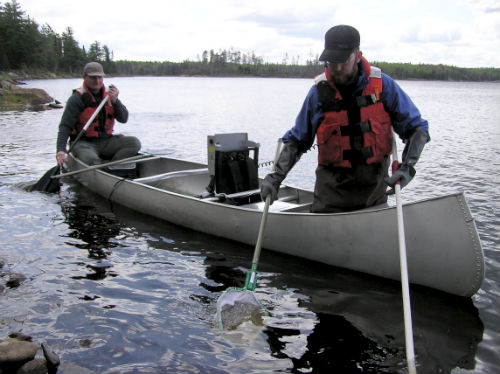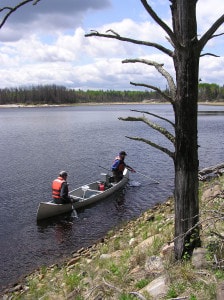
Remote lakes in Voyageurs National Park were essential to newly-published research showing promising trends in mercury contamination that results from air pollution. The toxic metal is the cause of most concern about fish consumption in Minnesota.
The wild Kabetogama Peninsula where the 11-year study was conducted provided certain challenges to scientists—and rewards. The unsullied and untrammeled character of the lakes meant they were free from other sources of pollution. It also meant that collecting fish and water samples meant traveling by boat, boots, and canoe.
“All of our sampling trips required boating across one of the big Park lakes—Kabetogama Lake to the south, and Rainy Lake to the north—then backpacking our equipment into the interior lakes,” says Mark Brigham, USGS scientist and lead author of the study. “So, the work was physically demanding, and you have to deal with the elements. We ran into rain mixed with snow one year during a May sampling trip. Of course, there are plenty of ticks and mosquitoes early in the summer, and deer flies and horse flies midsummer.”
Brigham adds that he isn’t complaining about the conditions; the trips served as a welcome break from his usual work in an office. The hopeful findings of the research are also rewarding.
The study found that drops in toxic mercury in fish and lake water correlate to American and Canadian reductions in emissions over recent decades. The results are particularly reliable because the research was done in wilderness waters, free from interference.

“Wilderness lakes are very important to study because the ecology and chemistry is not affected by development within the lakes’ watershed—no effects from highways, farms, urban areas, cabins, septic systems, or other disturbances. About the only human-related disturbance to wilderness lakes is deposition of atmospheric pollutants,” Brigham says.
That means that the decreases in mercury and other pollutants in the lakes is probably due to improved pollution controls on coal-fired power plants and other sources put in place in the 1980s, and regulations passed in 1990 that removed mercury from numerous consumer products such as batteries.
As pollutants in precipitation dropped by 32 percent between 1998 and 2012, mercury in two of the lakes dropped an average of 46 percent and 34 percent in the year-old yellow perch which were the focus of the research.
The young perch are a great sentinel species for the lakes and the ecosystem, Brigham explained in a MinnPost article, “My collaborators at the University of Wisconsin-Lacrosse have been big proponents of using these perch because they’re at a key point in the food chain. They eat of lot zooplankton and aquatic insects and other stuff that a small fish can fit into its mouth.”
Brigham went on to say that because the perch are consumed by everything from loons to northern pike—which are some of the most-mercury contaminated fish in most lakes—they can indicate how mercury might move up the food chain.
Meanwhile, another of the lakes studied, Brown Lake, received significantly more contaminated water from a polluted lake upstream, and mercury levels in fish rose accordingly. The fourth lake in the study, Shoepack Lake, saw no significant changes in mercury levels, which is attributed to a 2004 forest fire and a beaver dam blow-out in 2012 that reduced the lake’s size by half.
In a Duluth News Tribune article, Brigham says the mixed results call for cautious optimism, “We think (Shoepack and Brown) were the exceptions due to specific circumstances and that the results we saw in (Ryan and Peary) were likely more indicative of what’s going on regionally. But it’s clear that, even when we see major declines in mercury deposition levels, it’s not always going to mean lower mercury in all lakes. … They’re going to react differently.”
Due to the mixed results of the study, the study concludes not only that emission reductions do work in improving water and fish health, but also that the more study sites the better when it comes to understanding mercury trends, “We conclude that multiple study sites are desirable when assessing ecosystem responses to changes in atmospheric deposition of [mercury]. In the absence of a nationally coordinated program to assess mercury trends, which has been proposed but not yet implemented, case studies such as this provide valuable insights on trends in mercury in aquatic ecosystems.”
The entire study is available online here: http://pubs.acs.org/doi/abs/10.1021/es500301a.

